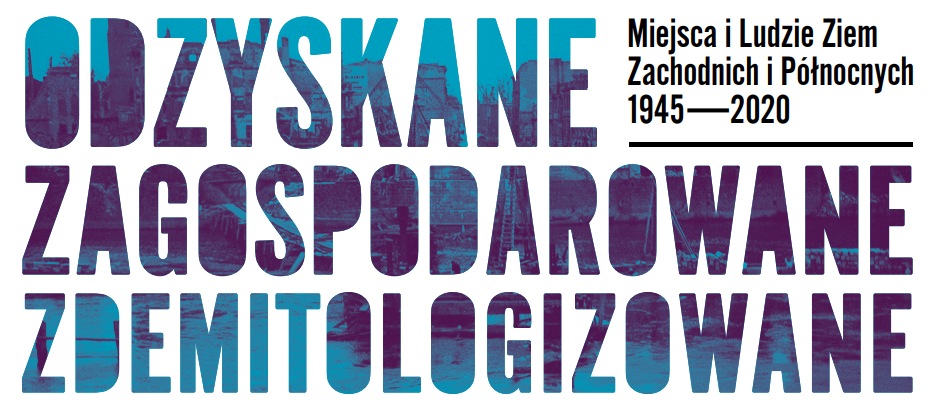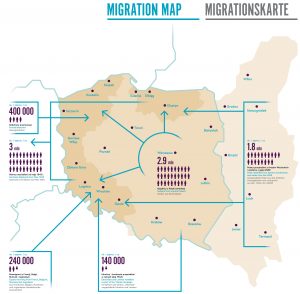
RECOVERED RECLAIMED DEMYTHOLOGIZED
PLACES AND PEOPLE IN THE WESTERN AND NORTHERN TERRITORIES IN 1945—2020
By a decision of the victorious powers that defeated the Third Reich, made in Yalta and approved at the Potsdam Conference in 1945, the Western and Northern Territories (the WNT) were annexed to Poland. Totaling 103,800 sq. km, the Territories amounted to one third of the area of modern Poland. They were given in compensation for the Eastern Borderlands lost by the Second Republic of Poland.
The decision displaced from these former German lands ca. three million Germans who made their departures between 1945 and 1948. Over a million indigenous people – Silesians, Kashubians, Masurians and Warmians – stayed behind. Some of the Polish forced laborers and concentration camp prisoners who ended up in the Territories at the end of World War II also remained there.
The year 1945 marked the start of a mass settlement and development campaign in the WNT that involved a mix of communities. The largest of them, numbering 2.9 million (i.e. about 50% of the total population), was made up of settlers from central Poland. Another large group were Poles from the Eastern Borderlands, which had been lost to the USSR. A total of 1.8 million repatriates came to the Recovered Territories in two waves of migration (1945–1948 and 1956–1959). In addition, ca. 400,000 of Polish forced laborers from the four Germanoccupied zones also made the WNT their home.
Roughly 240,000 of the settlers returned from emigration in France, Belgium, Romania, Yugoslavia, Czechoslovakia and England. One other unique community was comprised of 100,000–150,000 Soviet Army troops stationed in the WNT.
Between 1947 and 1950, approximately 140,000 Ukrainians and Lemkos were forcibly resettled from southeastern Poland into the WNT. Alongside Jews, Roma and political refugees from Greece and Macedonia, they added to a complex national and ethnic patchwork of the WNT. By 1946, the Recovered Territories were home to five million established and newlyarrived inhabitants. By 1955, their numbers reached seven million.
In addition to marking the 75th anniversary of the annexation of the Western and Northern Territories to Poland, the year 2020 was celebrated as the 120th anniversary of the birth of Zygmunt Wojciechowski, the founder and patron of the Institute for Western Affairs. Wojciechowski was
born on April 27, 1900 in the town of Stryj into a family of insurgents, the eldest child of the literary historian Konstanty Wojciechowski and Leontyna née Buczkowska.
Wojciechowski was strongly influenced by the nationalist movement that ran deep in Lviv.
He was a member of the November 11 Club. One particular influence on Wojciechowski’s
worldview was Roman Dmowski and his work “Germany, Russia and the Polish Question”,
which he read already in high school, and which inspired his subsequent concept of “Poland’s ancestral land”. During his legal, historical and philosophical studies in Lviv, Wojciechowski was also greatly influenced by Oswald Balzer and Jan Ptaśnik.
During World War I, Wojciechowski enlisted in the Legions and took part in the defense of Lviv, for which he was awarded the Lviv Defense Cross.
In 1925, a year after graduating from the Jan Kazimierz University of Lviv and obtaining a doctorate in philosophy, Wojciechowski came to Poznań, where he took the position of deputy professor at the Department of History of Political and Economic Systems and Old Polish Law at the Faculty of Law and Economics of the University of Poznań. In the same year in Poznań, he successfully completed his second-degree doctorate. From 1929, he was associate professor, and from January 1937 a full professor at the University of Poznań.
Before World War II, Wojciechowski created the concept of “Poland’s ancestral land”. He raised awareness of the Western Territories and was actively involved in the work of organizations preoccupied with Poland’s Western Territories and Polish-German relations, including the Scientific Society of Toruń, the Baltic Institute of Toruń and Gdynia, the Silesian Institute of Katowice, and the Gdańsk Society of the Friends of Science and Art.
From 1935 onwards, at Wojciechowski’s initiative and under his guidance, clandestine lectures were held in East Prussia, mainly on historical topics, including the history of Polish literature and art.
During the Nazi occupation, Wojciechowski was actively involved in the underground resistance movement. He lectured at the Western Territory University of Warsaw and served as advisor to Z. Kaczmarczyk and K. Kolańczyk, helping them to obtain their doctoral degrees. In 1941, he became head of the Western Studies, and, since 1944, led the Science Section in the Information Department of the Government Delegation for Poland. He was one of the founding members of the “Fatherland” organization and proposed ideas for delineating the new western borders of post-war Poland.
In December 1944, Wojciechowski organized the first clandestine founding meeting of a new institution: the Institute for Western Affairs, which, once the war ended, became the key organization preoccupied with Polish-German relations and the land annexed to Poland post World War II.
Wojciechowski headed the Institute until his death in 1955. He has been its patron since 1984.




